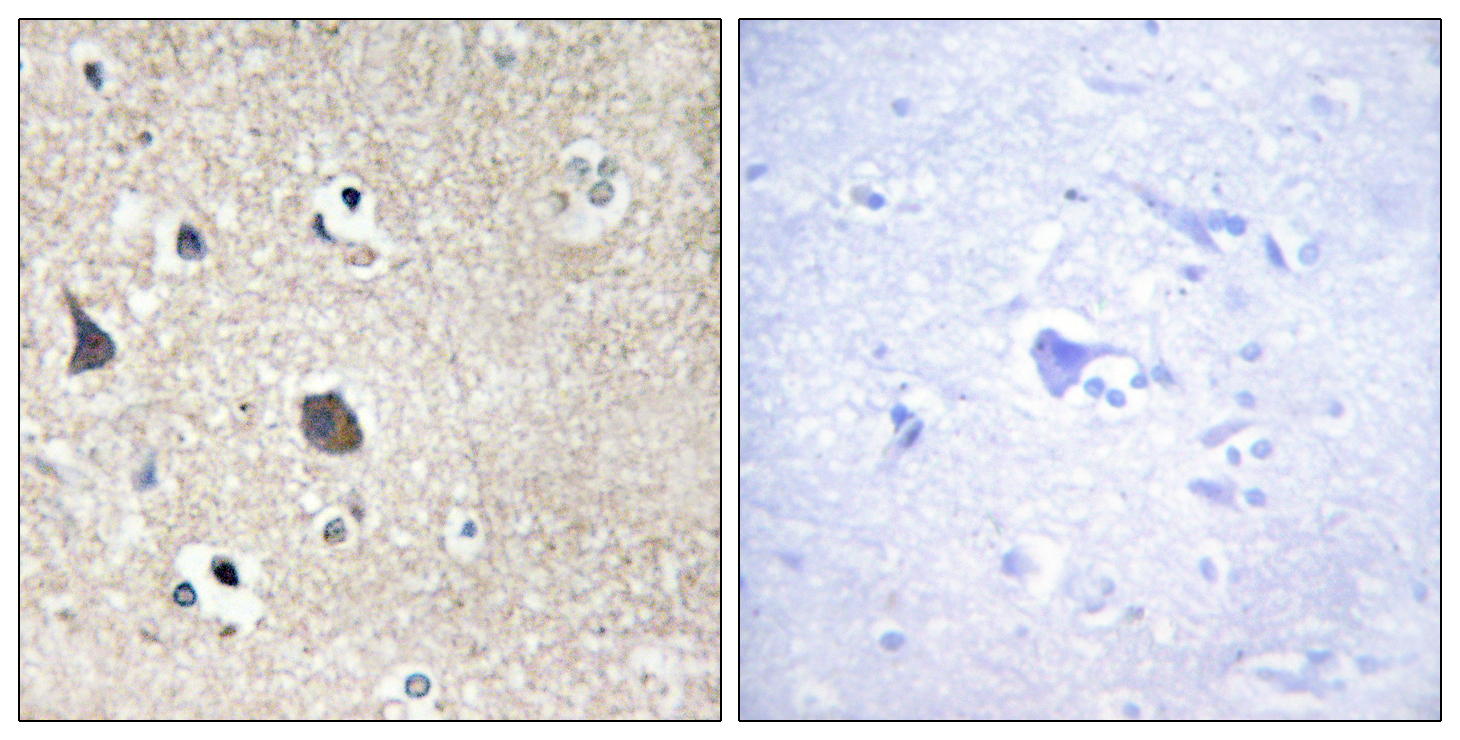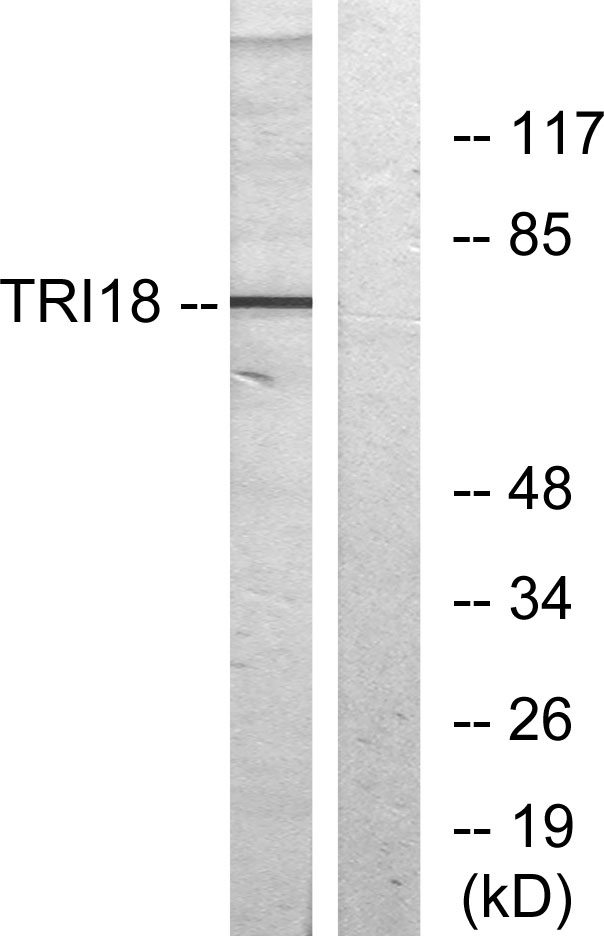Midline-1 Polyclonal Antibody
- Catalog No.:YT2760
- Applications:WB;IHC;IF;ELISA
- Reactivity:Human;Mouse;Rat
- Target:
- Midline-1
- Fields:
- >>Ubiquitin mediated proteolysis
- Gene Name:
- MID1
- Protein Name:
- Midline-1
- Human Gene Id:
- 4281
- Human Swiss Prot No:
- O15344
- Mouse Gene Id:
- 17318
- Mouse Swiss Prot No:
- O70583
- Rat Gene Id:
- 54252
- Rat Swiss Prot No:
- P82458
- Immunogen:
- The antiserum was produced against synthesized peptide derived from human TRI18. AA range:71-120
- Specificity:
- Midline-1 Polyclonal Antibody detects endogenous levels of Midline-1 protein.
- Formulation:
- Liquid in PBS containing 50% glycerol, 0.5% BSA and 0.02% sodium azide.
- Source:
- Polyclonal, Rabbit,IgG
- Dilution:
- WB 1:500 - 1:2000. IHC 1:100 - 1:300. IF 1:200 - 1:1000. ELISA: 1:40000. Not yet tested in other applications.
- Purification:
- The antibody was affinity-purified from rabbit antiserum by affinity-chromatography using epitope-specific immunogen.
- Concentration:
- 1 mg/ml
- Storage Stability:
- -15°C to -25°C/1 year(Do not lower than -25°C)
- Other Name:
- MID1;FXY;RNF59;TRIM18;XPRF;Midline-1;Midin;Midline 1 RING finger protein;Putative transcription factor XPRF;RING finger protein 59;Tripartite motif-containing protein 18
- Observed Band(KD):
- 75kD
- Background:
- midline 1(MID1) Homo sapiens The protein encoded by this gene is a member of the tripartite motif (TRIM) family, also known as the 'RING-B box-coiled coil' (RBCC) subgroup of RING finger proteins. The TRIM motif includes three zinc-binding domains, a RING, a B-box type 1 and a B-box type 2, and a coiled-coil region. This protein forms homodimers which associate with microtubules in the cytoplasm. The protein is likely involved in the formation of multiprotein structures acting as anchor points to microtubules. Mutations in this gene have been associated with the X-linked form of Opitz syndrome, which is characterized by midline abnormalities such as cleft lip, laryngeal cleft, heart defects, hypospadias, and agenesis of the corpus callosum. This gene was also the first example of a gene subject to X inactivation in human while escaping it in mouse. Multiple different transcript variants are generated by alternate splicing; however, t
- Function:
- disease:Defects in MID1 are the cause of Opitz syndrome type I (OS-I) [MIM:300000]. OS-I is an X-linked recessive disorder characterized by hypertelorism, genital-urinary defects such as hypospadias in males and splayed labia in females, lip-palate-laryngotracheal clefts, imperforate anus, developmental delay and congenital heart defects. OS-I mutations produce proteins with a decreased affinity for microtubules.,function:May have E3 ubiquitin ligase activity which targets the catalytic subunit of protein phosphatase 2 for degradation.,induction:A retroviral element acts as an alternative tissue-specific promoter for this gene. The LTR of an HERV-E element enhances the expression in placenta and embryonic kidney.,PTM:Phosphorylated on serine and threonine residues.,similarity:Belongs to the TRIM/RBCC family.,similarity:Contains 1 B30.2/SPRY domain.,similarity:Contains 1 COS domain.,simil
- Subcellular Location:
- Cytoplasm . Cytoplasm, cytoskeleton . Cytoplasm, cytoskeleton, spindle . Microtubule-associated. It is associated with microtubules throughout the cell cycle, co-localizing with cytoplasmic fibers in interphase and with the mitotic spindle and midbodies during mitosis and cytokinesis.
- Expression:
- In the fetus, highest expression found in kidney, followed by brain and lung. Expressed at low levels in fetal liver. In the adult, most abundant in heart, placenta and brain.
- June 19-2018
- WESTERN IMMUNOBLOTTING PROTOCOL
- June 19-2018
- IMMUNOHISTOCHEMISTRY-PARAFFIN PROTOCOL
- June 19-2018
- IMMUNOFLUORESCENCE PROTOCOL
- September 08-2020
- FLOW-CYTOMEYRT-PROTOCOL
- May 20-2022
- Cell-Based ELISA│解您多样本WB检测之困扰
- July 13-2018
- CELL-BASED-ELISA-PROTOCOL-FOR-ACETYL-PROTEIN
- July 13-2018
- CELL-BASED-ELISA-PROTOCOL-FOR-PHOSPHO-PROTEIN
- July 13-2018
- Antibody-FAQs
- Products Images

- Western Blot analysis of various cells using Midline-1 Polyclonal Antibody
.jpg)
- Western Blot analysis of 293 cells using Midline-1 Polyclonal Antibody

- Immunofluorescence analysis of HeLa cells, using TRI18 Antibody. The picture on the right is blocked with the synthesized peptide.

- Immunohistochemistry analysis of paraffin-embedded human brain tissue, using TRI18 Antibody. The picture on the right is blocked with the synthesized peptide.

- Western blot analysis of lysates from 293 cells, using TRI18 Antibody. The lane on the right is blocked with the synthesized peptide.



